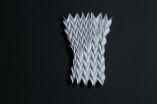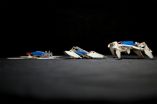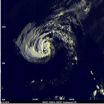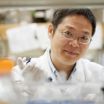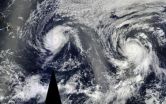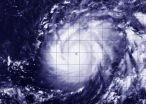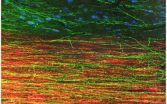(Press-News.org) AMHERST, Mass. -- A challenge increasingly important to physicists and materials scientists in recent years has been how to design controllable new materials that exhibit desired physical properties rather than relying on those properties to emerge naturally, says University of Massachusetts Amherst physicist Christian Santangelo.
Now he and physicist Arthur Evans and polymer scientist Ryan Hayward at UMass Amherst, with others at Cornell and Western New England University, are using origami-based folding methods for "tuning" the fundamental physical properties of any type of thin sheet, which may eventually lead to development of molecular-scale machines that could snap into place and perform mechanical tasks. Results are reported today in an early online edition of Science.
At a physics meeting a couple of years ago, Santangelo mentioned the unusual properties of a special type of origami fold called Miura-ori to fellow physicist Jesse Silverberg of Cornell, a long-time origami enthusiast. Miura-ori, named after the astrophysicist who invented the technique, is a series folded parallelograms that change the stiffness of a sheet of paper based only on the crease pattern.
Also known as tessellation, this special folding, which occurs naturally in some leaves and tissues, arranges a flat surface using a repeated pattern of alternating mountain-and-valley zigzag folds. Objects folded this way contract when squeezed, a bit like an accordion, so they can be packed into a very small shape but unfolded with little effort from the corners. This technique has been used in space to launch satellites with solar arrays that can be unfolded using only a few small motors at the edges.
Santangelo explains, "As you compress most materials along one axis, they expand in other directions. In other words, squeezing a hunk of material causes it to leak out the sides. A rare class of materials, however, does the opposite. If you compress them along one direction, they collapse uniformly in all directions. Miura-ori shows us how to use this property to make new devices. Exotic materials can be formed from traditional materials simply by altering microscopic structure."
Santangelo, with Silverberg and Itai Cohen at Cornell and Tom Hull at Western New England, describe in their new paper how to alter patterns and introduce defects to tune a thin sheet's stiffness and create a material in which physical properties can be programmed and reprogrammed.
Silverberg says, "The work brings together origami, metamaterials, programmable matter crystallography and more. It's totally bizarre and unique to have so many of these ideas intersecting at the same time."
Santangelo says active materials can change their shape, size, and/or physical properties with changes in temperature, pressure, electro-magnetic fields, or other aspects of their environment. With such materials, researchers may be able to create entire structures and systems out of single pieces that are flexible, elastic and resilient.
Santangelo adds, "In particular, this gives us the ability to make a reprogrammable material. By toggling elements of the origami structure between two stable states, we can make the structure stiffer, selectively weaken certain parts, and so on. And we can do it reversibly. Given origami's scale-free geometric character, this framework for metamaterial design can be directly transferred to milli-, micro- and nanometer size systems."
He adds that metamaterials are rapidly emerging at the frontier of scientific and technological innovation due to their exotic and tunable material properties, which arise from arrangements of smaller units within the bulk system to generate exotic, non-natural properties on larger scales. Miura-ori can be considered a mechanical metamaterial because its stiffness can be controlled by the specific fold angles of the parallelograms, Silverberg explains.
The physicists point out that is rare to find metamaterials that can be reconfigured beyond their original design, but origami-inspired mechanical metamaterials offer enhanced flexibility because their properties are linked to alterable folding pattern. So-called "pop-through defects" made by changing crease directions, can be introduced to change a sheet's stiffness, so multiple stable configurations can come from a single structure yielding programmable metamaterials.
Using numerical simulations, Evans and Santangelo calculated the effect that a pop-through defect has on Miura-ori. They showed that it instantly makes the entire sheet stiffer, and the effect is additive. The Cornell group will present this research at the Sixth International Meeting on Origami in Science, Mathematics and Education on Aug. 10 in Tokyo.
INFORMATION: END
Learning from origami to design new materials
Physicists and materials scientists are using origami-based folding methods for 'tuning' physical properties of any type of thin sheet, which may lead to developing molecular-scale machines that could snap into place and perform mechanical tasks
2014-08-07
ELSE PRESS RELEASES FROM THIS DATE:
Robot folds itself up and walks away
2014-08-07
A team of engineers used little more than paper and Shrinky dinks™ – the classic children's toy that shrinks when heated – to build a robot that assembles itself into a complex shape in four minutes flat, and crawls away without any human intervention. The advance, described in Science, demonstrates the potential to quickly and cheaply build sophisticated machines that interact with the environment, and to automate much of the design and assembly process. The method draws inspiration from self-assembly in nature, such as the way linear sequences of amino acids fold into ...
Origami robot folds itself up, crawls away
2014-08-07
For years, a team of researchers at MIT and Harvard University has been working on origami robots — reconfigurable robots that would be able to fold themselves into arbitrary shapes.
In the August 7 issue of Science, they report their latest milestone: a robot, made almost entirely from parts produced by a laser cutter, that folds itself up and crawls away as soon as batteries are attached to it.
"The exciting thing here is that you create this device that has computation embedded in the flat, printed version," says Daniela Rus, the Andrew and Erna Viterbi Professor ...
NASA sees heavy rainfall in Iselle as the hurricane nears Hawaii
2014-08-07
VIDEO:
TRMM satellite rainfall data overlaid on an enhanced infrared image from NOAA's GOES-West satellite shows heavy rainfall occurring around the Iselle's eye. The most intense rain was falling at a...
Click here for more information.
A NASA satellite has observed heavy rainfall in Hurricane Iselle on its approach to Hawaii. NASA's TRMM Satellite captured rainfall rates within the storm as it passed overhead. In addition, NASA's Aqua satellite provided a larger view of the Central ...
Cell signaling pathway linked to obesity, type 2 diabetes
2014-08-07
WEST LAFAYETTE, Ind. - A Purdue University study shows that Notch signaling, a key biological pathway tied to development and cell communication, also plays an important role in the onset of obesity and Type 2 diabetes, a discovery that offers new targets for treatment.
A research team led by Shihuan Kuang, associate professor of animal sciences, found that blocking Notch signaling in the fat tissue of mice caused white fat cells to transform into a "leaner" type of fat known as beige fat. The finding suggests that suppressing Notch signaling in fat cells could reduce ...
Gut microbes browse along a gene buffet
2014-08-07
DURHAM, N.C. -- In the moist, dark microbial rainforest of the intestine, hundreds of species of microorganisms interact with each other and with the cells of the host animal to get the resources they need to survive and thrive.
Though there's a lot of competition in this vibrant ecosystem, collaboration is valued too. A new study on the crosstalk between microbes and cells lining the gut of mice shows just how cooperative this environment can be.
One of the main ways that hosts manage their interactions with microbes is by carefully controlling the genes that their ...
NASA sees Hurricane Julio organize and emit a gamma-ray flash
2014-08-07
NASA's Fermi and Aqua satellites captured two different views of bursts of strength show by Hurricane Julio as it intensified. NASA's Fermi satellite saw a gamma-ray flash from Julio, while NASA's Aqua satellite saw Julio become more structurally organized as a hurricane.
This type of outburst is known as a terrestrial gamma-ray flash (TGF). Produced by the powerful electric fields in thunderstorms, TGFs last only a few thousandths of a second but emit gamma rays that make up the highest-energy naturally-occurring light on Earth. Scientists estimate that, on average, ...
Wild sheep show benefits of putting up with parasites
2014-08-07
In the first evidence that natural selection favors an individual's infection tolerance, researchers from Princeton University and the University of Edinburgh have found that an animal's ability to endure an internal parasite strongly influences its reproductive success. Reported in the journal PLoS Biology, the finding could provide the groundwork for boosting the resilience of humans and livestock to infection.
The researchers used 25 years of data on a population of wild sheep living on an island in northwest Scotland to assess the evolutionary importance of infection ...
NASA sees Genevieve cross international date line as a Super-Typhoon
2014-08-07
Tropical Storm Genevieve had ups and downs in the Eastern Pacific and Central Pacific over the last week but once the storm crossed the International Dateline in the Pacific, it rapidly intensified into a Super Typhoon. NASA-NOAA's Suomi NPP satellite captured of the storm.
When Suomi NPP flew over Genevieve on August 7 at 01:48 UTC the Visible Infrared Imaging Radiometer Suite (VIIRS) instrument aboard captured an infrared image of the storm. VIIRS collects visible and infrared imagery and global observations of land, atmosphere, cryosphere and oceans. VIIRS flies aboard ...
Dramatic growth of grafted stem cells in rat spinal cord injuries
2014-08-07
Building upon previous research, scientists at the University of California, San Diego School of Medicine and Veteran's Affairs San Diego Healthcare System report that neurons derived from human induced pluripotent stem cells (iPSC) and grafted into rats after a spinal cord injury produced cells with tens of thousands of axons extending virtually the entire length of the animals' central nervous system.
Writing in the August 7 early online edition of Neuron, lead scientist Paul Lu, PhD, of the UC San Diego Department of Neurosciences and colleagues said the human iPSC-derived ...
Human skin cells reprogrammed as neurons regrow in rats with spinal cord injuries
2014-08-07
While neurons normally fail to regenerate after spinal cord injuries, neurons formed from human induced pluripotent stem cells (iPSCs) that were grafted into rats with such injuries displayed remarkable growth throughout the length of the animals' central nervous system. What's more, the iPSCs were derived from skin cells taken from an 86-year-old man. The results, described in the Cell Press journal Neuron, could open up new possibilities in stimulating neuron growth in humans with spinal cord injuries
"These findings indicate that intrinsic neuronal mechanisms readily ...
LAST 30 PRESS RELEASES:
Tracing the quick synthesis of an industrially important catalyst
New software sheds light on cancer’s hidden genetic networks
UT Health San Antonio awarded $3 million in CPRIT grants to bolster cancer research and prevention efforts in South Texas
Third symposium spotlights global challenge of new contaminants in China’s fight against pollution
From straw to soil harmony: International team reveals how biochar supercharges carbon-smart farming
Myeloma: How AI is redrawing the map of cancer care
Manhattan E. Charurat, Ph.D., MHS invested as the Homer and Martha Gudelsky Distinguished Professor in Medicine at the University of Maryland School of Medicine
Insilico Medicine’s Pharma.AI Q4 Winter Launch Recap: Revolutionizing drug discovery with cutting-edge AI innovations, accelerating the path to pharmaceutical superintelligence
Nanoplastics have diet-dependent impacts on digestive system health
Brain neuron death occurs throughout life and increases with age, a natural human protein drug may halt neuron death in Alzheimer’s disease
SPIE and CLP announce the recipients of the 2025 Advanced Photonics Young Innovator Award
Lessons from the Caldor Fire’s Christmas Valley ‘Miracle’
Ant societies rose by trading individual protection for collective power
Research reveals how ancient viral DNA shapes early embryonic development
A molecular gatekeeper that controls protein synthesis
New ‘cloaking device’ concept to shield sensitive tech from magnetic fields
Researchers show impact of mountain building and climate change on alpine biodiversity
Study models the transition from Neanderthals to modern humans in Europe
University of Phoenix College of Doctoral Studies releases white paper on AI-driven skilling to reduce burnout and restore worker autonomy
AIs fail at the game of visual “telephone”
The levers for a sustainable food system
Potential changes in US homelessness by ending federal support for housing first programs
Vulnerability of large language models to prompt injection when providing medical advice
Researchers develop new system for high-energy-density, long-life, multi-electron transfer bromine-based flow batteries
Ending federal support for housing first programs could increase U.S. homelessness by 5% in one year, new JAMA study finds
New research uncovers molecular ‘safety switch’ shielding cancers from immune attack
Bacteria resisting viral infection can still sink carbon to ocean floor
Younger biological age may increase depression risk in older women during COVID-19
Bharat Innovates 2026 National Basecamp Showcases India’s Most Promising Deep-Tech Ventures
Here’s what determines whether your income level rises or falls
[Press-News.org] Learning from origami to design new materialsPhysicists and materials scientists are using origami-based folding methods for 'tuning' physical properties of any type of thin sheet, which may lead to developing molecular-scale machines that could snap into place and perform mechanical tasks
